The Waxing Moon Meets Mars and Joins Gemini While Crossing the Sacred Hoop and We Wave Farewell to Jupiter and Hello to Mercury While Venus Vaults Higher!

This spectacular image by my friend Andrea Girones was taken recently at Morant’s Curve, Alberta using a DSLR with a 20mm lens on a star tracking mount. It captures the arc of faintly glowing reddish hydrogen gas around Orion and the nimbus around his head (at left), the bright compact Rosette Nebula (upper left), Mars (top centre), the Pleiades cluster (right of centre), and brilliant Venus embedded within the tilted band of the zodiacal light (lower right). Her original FaceBook post is here.
Hello, Early Spring Stargazers!
Here are your Astronomy Skylights for the week of March 26th, 2023 by Chris Vaughan. Feel free to pass this along to your friends and send me your comments, questions, and suggested topics. You can also follow me on Twitter as @astrogeoguy! Unless otherwise noted, all times are expressed in Eastern Time. To subscribe to these emails please click this MailChimp link.
If you’d like me to bring my Digital Starlab portable inflatable planetarium to your school or other daytime or evening event, or deliver a session online, contact me through AstroGeo.ca, and we’ll tour the Universe, or the Earth’s interior, together! My terrific book with John A. Read entitled 110 Things to See With a Telescope is a guide to viewing the deep sky objects in the Messier List – for both beginners and seasoned astronomers. DM me to order a signed copy!
The moon will grow in phase and brightness this week as it swings away from the evening sun – on the way passing through the Winter Hexagon / Sacred Hoop, meeting Mars, and Joining Gemini. Jupiter drops out of sight as Mercury begins its best evening appearance. Read on for your Skylights!
The Moon Crosses the Sacred Hoop
The moon will shine in the evening sky worldwide this week as it waxes from a crescent to gibbous. The moon’s illuminated portion, or phase, increases because the angle between you, the sun, and the moon is increasing while the moon slides continuously eastward in its orbit around Earth. For several nights after new moon, the angle between the sun and the moon is very acute – with values less than about 45°. Since the moon is closer to the sun than we are at that part of the lunar month, most of the sunlight strikes the far side of the moon, leaving the majority of the Earth-facing side dark. That makes Earth-bound observers see a crescent moon.
When the moon reaches its first quarter phase, about seven days after the prior new moon, it’s about the same distance from the sun as Earth is, so the angle between the sun and moon becomes 90° and the moon looks half-illuminated in the sky. For the seven days following first quarter, the moon gets increasingly farther from the sun than Earth is, so more than half of its Earth-facing hemisphere receives sunlight and the moon looks gibbous. At the end of that week, the moon becomes about 180° from the sun. That’s when we see a completely illuminated full moon.
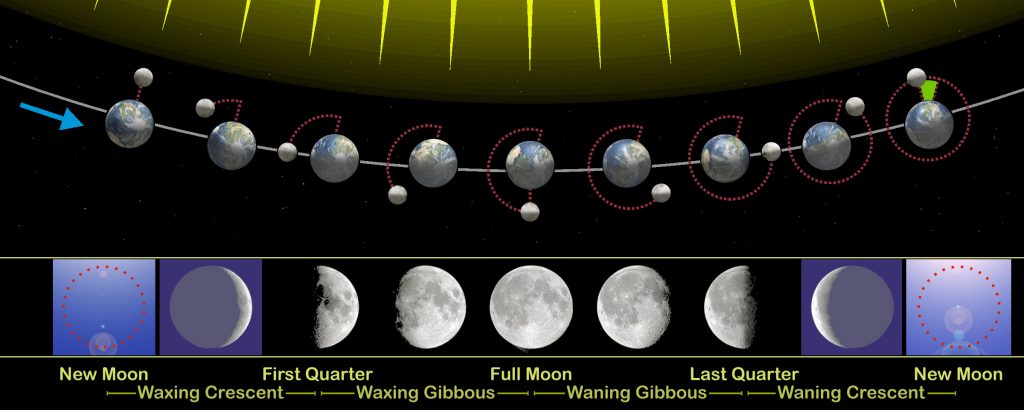
During the two weeks that follow a full moon, the moon reduces its angle from the pre-dawn sun and also moves closer to the sun. We see a half-illuminated third quarter moon during the morning hours when the angle passes 90°, and then the moon wanes to a crescent towards new moon, and the cycle starts again. Moon phases occur independently of Earth’s rotation, so the moon might not be in your sky at the precise moment a phase is reached.
The pole-to-pole boundary that separates the moon’s lit and dark hemispheres is called the terminator. Along that line, which is curved except at first and third quarter phase, the sun is just rising (or just setting if the morning moon is waning). The rising Sun’s rays are nearly horizontal alongside the terminator, so they cast long shadows. Even the smallest hillock will stand out under that illumination, which is why we choose those times to see subtle features in telescopes.
Since there is no atmosphere on the moon to scatter light, the shadows are a deep black – producing breathtaking vistas through binoculars and telescopes. Since the terminator migrates across the moon’s disk hour-by-hour and night-after-night, new scenery is highlighted every time you check back. Central peaks in deep craters will catch the light while surrounded by pools of inky blackness. Partially illuminated craters’ rims cast shadows across their floors, telling us whether they are bowl-shaped or more like pie plates. The latter happens when an old crater has been flooded with lava or filled with elected debris. We can learn a lot about the moon’s history just by looking at it!
This week’s moon will be rising in daytime and then lingering into late evening – so even the youngest astronomers can have a look. It’s perfectly safe to use binoculars or a telescope on the moon in daytime, too – as long as no one aims them towards the sun.
Tonight (Sunday) the 30%-illuminated crescent moon will shine near a large triangle of three prominent reddish points of light in the western sky. The bright star Aldebaran in Taurus (the Bull) will shine to the moon’s lower left (or celestial south), the star Betelgeuse in Orion (the Hunter) will appear 2.5 fist diameters to the moon’s left (or southeast), and the reddish planet Mars will shine two fist diameters to the moon’s upper left, or east). The Pleiades star cluster will sparkle a fist’s diameter to the moon’s lower right.
Sunday night’s moon will be starting its monthly trip through the big Winter Hexagon asterism. Also called the Winter Football, the Winter Circle, it is composed of the brightest stars in the constellations of Canis Major, Orion, Taurus, Auriga, Gemini, and Canis Minor – specifically Sirius, Rigel, Aldebaran, Capella, Castor & Pollux, and Procyon. The hexagon is visible from mid-November to spring every year. Viewed during evening from mid-Northern latitudes, the huge pattern will stretch across the southwestern sky with its top star Capella leaning west. The ecliptic bisects the asterism. The waxing moon will pass through the giant shape until Wednesday this week, overtaking the reddish dot of Mars, which will drift through its middle until early May. Venus will enter it toward the end of April.
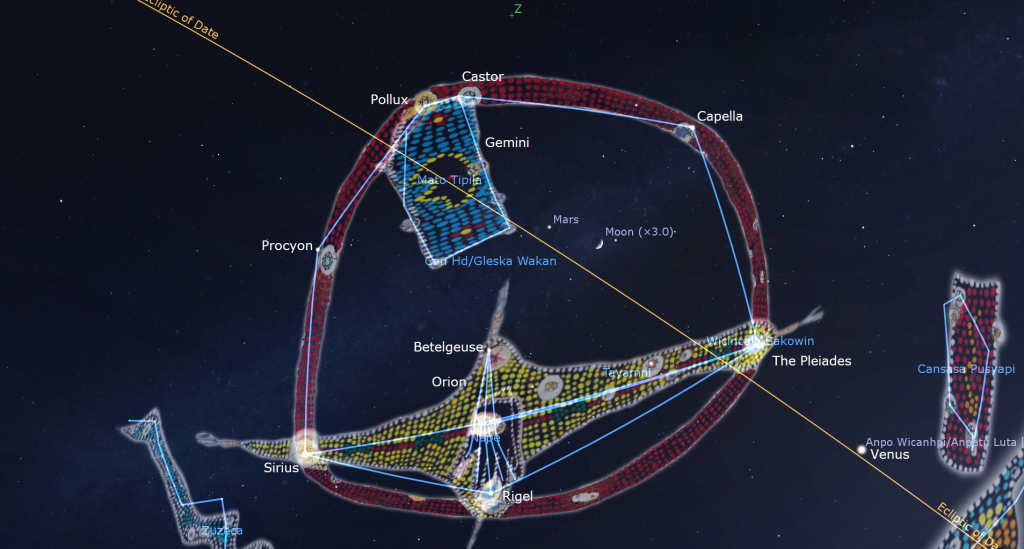
The Lakota people of central North America saw a modified version of the pattern called Cangleska Wakan “the Sacred Hoop”. They include the Pleiades cluster, which they call Wicincala Sakowin “Seven Little Girls”. The Sacred Hoop encloses Tayamni, an animal composed of the Pleiades (its head), Orion (its spine and ribs), and Sirius (its tail). The boxy stars of Gemini become Mato Tipila “the Bear’s Den”. To them the Sacred Hoop is the stellar embodiment of the “unending circle of time, space, matter, and spirit.”
In the western sky on Monday evening, watch for the nearly half-illuminated waxing moon shining a palm’s width to the lower right (or 6 degrees to the celestial WNW) of Mars. As they descend the western sky together, the moon’s steady eastward motion around Earth will draw it closer to Mars, eventually allowing them to share the view in binoculars. Observers in westerly time zones will see the pair even closer together. For observers in Asia, the moon will pass only 2 degrees to the north of Mars after midnight.
In the Americas the moon and Mars will shine together again on Tuesday evening, with the moon positioned a palm’s width above Mars – thanks to our natural satellite’s 12° shift eastward in 24 hours. The moon will complete the first quarter of its orbit around Earth at 02:32 Greenwich Mean Time on Wednesday, March 29, which converts to 10:32 pm EDT and 7:32 pm PDT on Tuesday evening. Check out the straight line of the terminator that night.
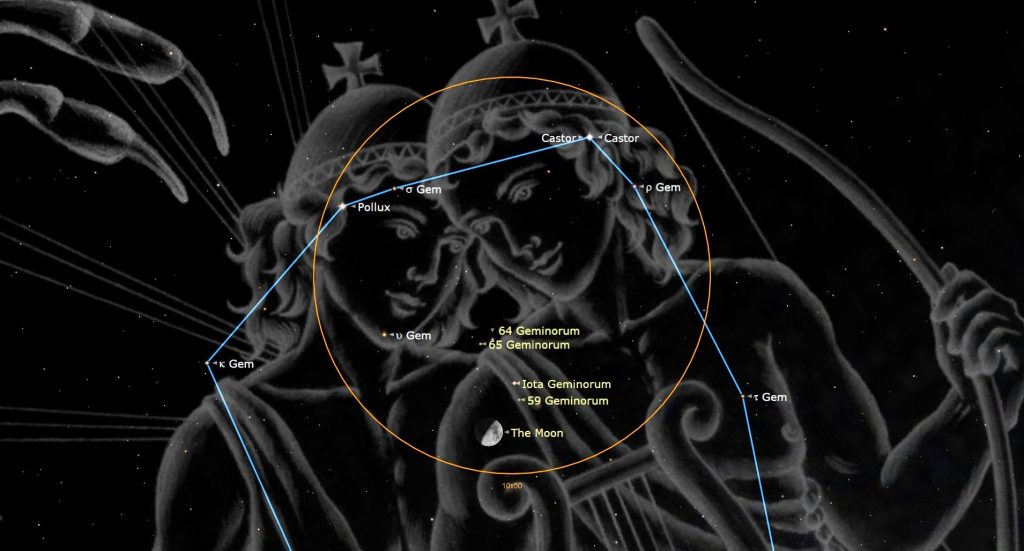
On Wednesday the slightly gibbous moon will rise around noon local time. Once the sky darkens in early evening, the stars of Gemini (the Twins) will appear around it. High in the southern sky, Gemini’s two brightest stars, the “twins” Castor and Pollux, will sparkle several finger widths to the upper left (or celestial northeast) of the moon. The grouping will be tight enough for the trio to share the field of view in binoculars. Optical aids will also show the fainter stars Iota, 59, 64, and 65 Geminorum shining where the celestial siblings rub shoulders. Observers viewing the scene later, or in more westerly time zones, will see the moon closer to Pollux. Meanwhile, the diurnal rotation of the sky will swing the moon underneath Pollux before they set in the wee hours.

Also on Wednesday (and Thursday, too) the terminator will fall just to the left (or lunar west) of Rupes Recta, also known as the Lunar Straight Wall. The rupes, Latin for “cliff”, is a north-south aligned fault scarp that extends for 110 km across the southeastern part of Mare Nubium, the Sea of Clouds. That’s the dark patch sitting in the lower third of the moon’s Earth-facing hemisphere. The wall, which is very easy to see in good binoculars and backyard telescopes, is located above the very bright crater Tycho.
The bright moon will spend Thursday and Friday crossing the faint stars of Cancer (the Crab). It will begin April shining brightly among the stars of Leo (the Lion).
The Planets
Jupiter will put on one last show before it leaves the stage until next summer’s return engagement. If you have a cloud-free, unobstructed horizon toward the west after sunset on Monday, wait until the sun has fully set, then pull out your binoculars and scan the sky just above the western horizon for Jupiter shining a thumb’s width to the left (or celestial south) of Mercury. If you live closer to the tropics you’ll see the duo more easily. If Monday is cloudy, then check on Tuesday, when Mercury will have climbed to Jupiter’s upper right. By next Sunday night, Mercury will be easily spotted after sunset, but Jupiter will be gone. This arrival of Mercury will develop into its best evening appearance of the year for mid-Northern latitude observers – between now and mid-April.

Venus will get brighter and higher each week. The brilliant planet will be the “Evening Star” until early July. This week Venus will catch your eye in the lower part of the western sky starting after sunset. It will descend and set before 11 pm in your local time zone. Long before then our sister planet will be shining in a dark sky among the stars of Aries (the Ram). Viewed in a telescope this week, Venus will display a gibbous 78%-illuminated disk that is slowly waning each night. To see Venus’ rugby ball shape most clearly in a telescope, view the planet as soon as you can locate it through your optics, when it will be higher and shining through less intervening air. Again – take care to avoid aiming a telescope or binoculars near the sun.

Venus’ eastward orbital motion has been carrying the planet towards far fainter Uranus. On Thursday evening, magnitude 5.8 Uranus will be positioned a just finger’s width to the lower left (or 1 degree to the celestial south) of Venus. That’s cozy enough to see them together in a backyard telescope. The two planets began to share the view in binoculars this weekend, when Uranus is several finger widths above Venus. After their closest approach on Thursday, Venus will climb higher than Uranus each evening. The last night for them to appear together in binoculars will be April 4.
Mars’ own eastward trek continues to help it delay its inevitable drop into the west. Meanwhile, it continues to fade in brightness and become smaller in telescopes as Earth increases its distance from the red planet. After dusk tonight (Sunday), Mars will appear in western Gemini (the Twins), about two-thirds of the way up the southwestern sky. That will be its absolute best telescope viewing time – it’s all down from there. Mars’ still-prominent reddish dot will form a red triangle above and between the bright, reddish star Aldebaran, which marks the angry eye of the bull, and ruddy Betelgeuse at Orion’s shoulder. Mars is a little fainter than Aldebaran now. The planet will set during the wee hours of the night.
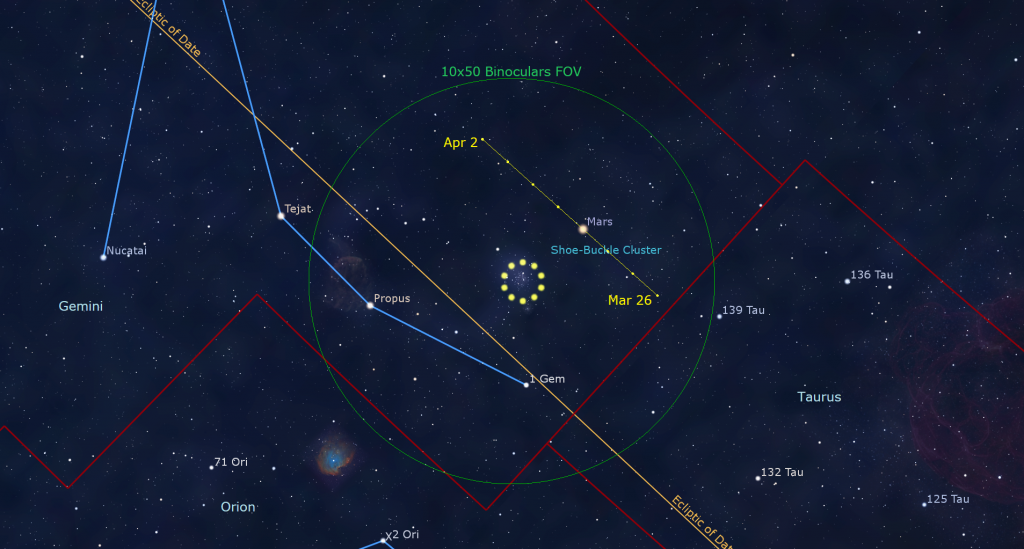
For several nights surrounding Wednesday, the orbital motion of the reddish planet Mars will carry it closely past the large and prominent open star cluster in Gemini designated Messier 35, NGC 2168, and the Shoe-Buckle Cluster. Mars and the cluster will share the view in binoculars until April 8 and the eyepiece of a backyard telescope from Tuesday to Thursday. At their closest approach on Wednesday night, the cluster’s sprinkling of several hundred stars will be centered a finger’s width to the lower left (or 1 degree to the celestial south) of Mars.
The dwarf planet Ceres’ westerly retrograde loop through the northern edge of the Virgo Cluster of Galaxies will carry it very close to another spectacular spiral galaxy for several nights starting tonight (Sunday). Messier 100 is a grand design, face-on spiral galaxy located a bit more than halfway from the bright star Diadem in Coma Berenices (Berenices Hair) to Denebola in Leo (the Lion). The 7th magnitude dwarf planet will brush the northern edge of the bright spiral’s arms on Sunday evening, but they’ll be close enough to view together in a backyard telescope until Wednesday. The early-setting crescent moon should allow the galaxy and the asteroid to be visible in full-sized binoculars from a dark sky location in late evening, when they’ll be high in the southern sky.
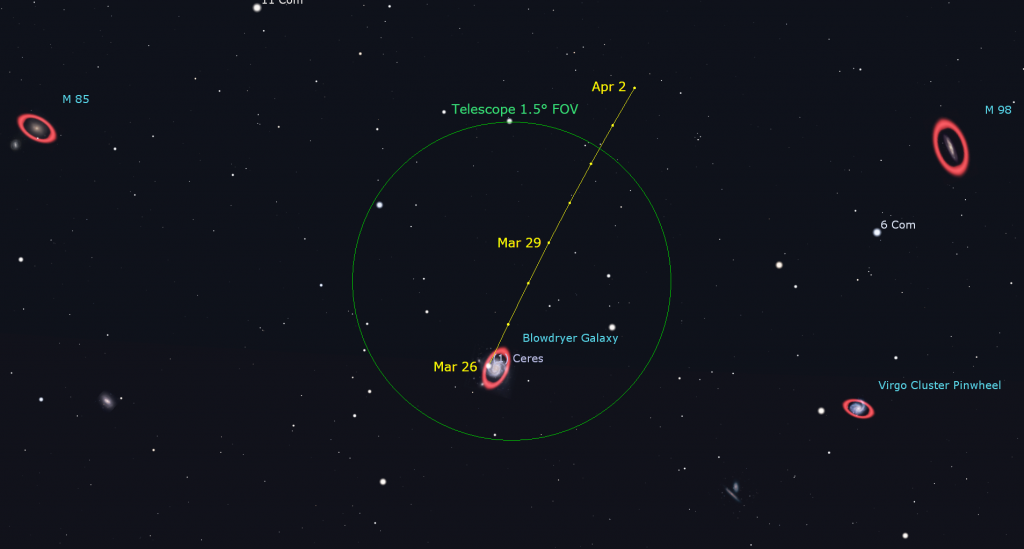
Over the coming weeks Saturn will gradually return to visibility in the east before sunrise.
Public Astro-Themed Events
Every Monday evening, York University’s Allan I. Carswell Observatory runs an online star party – broadcasting views from four telescopes/cameras (weather permitting), answering viewer questions, and taking requests! Details are here. They host in-person viewing on the first clear Wednesday night each month. On Wednesdays they stream views online via the observatory YouTube channel. Details are here.
My free, family-friendly Insider’s Guide to the Galaxy webcast with RASC National returns on Tuesday, March 28 at 3:30 pm EST. We’ll talk about a fascinating topic in astronomy. Then we’ll wrap up by highlighting our first batch of spring RASC Finest NGC objects. You can find more details and the schedule of future sessions here.
Keep looking up, and enjoy the sky when you do. I love questions and requests. Send me some!